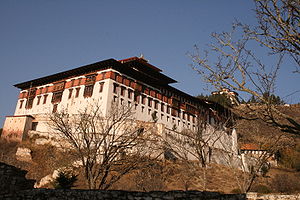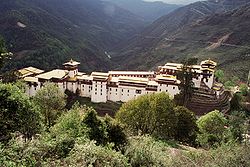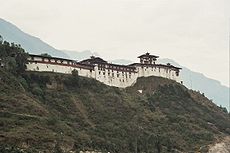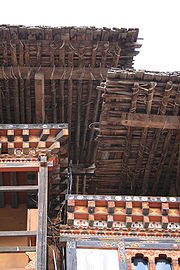
Dzong architecture
Encyclopedia

Dzong architecture is a distinctive type of fortress architecture
Architectural style
Architectural styles classify architecture in terms of the use of form, techniques, materials, time period, region and other stylistic influences. It overlaps with, and emerges from the study of the evolution and history of architecture...
found in the present and former Buddhist kingdoms of the Himalayas
Himalayas
The Himalaya Range or Himalaya Mountains Sanskrit: Devanagari: हिमालय, literally "abode of snow"), usually called the Himalayas or Himalaya for short, is a mountain range in Asia, separating the Indian subcontinent from the Tibetan Plateau...
: Bhutan
Bhutan
Bhutan , officially the Kingdom of Bhutan, is a landlocked state in South Asia, located at the eastern end of the Himalayas and bordered to the south, east and west by the Republic of India and to the north by the People's Republic of China...
and Tibet
Tibet
Tibet is a plateau region in Asia, north-east of the Himalayas. It is the traditional homeland of the Tibetan people as well as some other ethnic groups such as Monpas, Qiang, and Lhobas, and is now also inhabited by considerable numbers of Han and Hui people...
. The architecture is massive in style with towering exterior walls surrounding a complex of courtyards, temples, administrative offices, and monks' accommodation.
Characteristics
Distinctive features include:- High inward sloping walls of brick and stone painted white with few or no windows in the lower sections of the wall
- Use of a surrounding red ochre stripe near the top of the walls, sometimes punctuated by large gold circles.
- Use of ChineseChinese architectureChinese architecture refers to a style of architecture that has taken shape in East Asia over many centuries. The structural principles of Chinese architecture have remained largely unchanged, the main changes being only the decorative details...
-style flared roofs atop interior temples. - Massive entry doors made of wood and iron
- Interior courtyards and temples brightly colored in Buddhist-themed art motifs such as the ashtamangalaAshtamangalaAshtamangala or Zhaxi Daggyai are a sacred suite of Eight Auspicious Signs endemic to a number of Dharmic Traditions such as Hinduism, Jainism, and Buddhism. The symbols or 'symbolic attributes' are yidam and teaching tools...
or swastikaSwastikaThe swastika is an equilateral cross with its arms bent at right angles, in either right-facing form in counter clock motion or its mirrored left-facing form in clock motion. Earliest archaeological evidence of swastika-shaped ornaments dates back to the Indus Valley Civilization of Ancient...
, for example.
Bhutan
Dzongs serve as the religious, military, administrative, and social centers of their district. They are often the site of an annual tsechuTsechu
Tsechu are annual religious Bhutanese festivals held in each district or dzongkhag of Bhutan on the tenth day of a month of the lunar Tibetan calendar. The month depends on the place, but usually is around the time of October. Tsechus are religious festivals of Drukpa Buddhism...
or religious festival.
The rooms inside the dzong are typically allocated half to administrative function (such as the office of the penlop
Penlop
Penlop is a Dzongkha term roughly translated as governor. Bhutanese penlops, prior to unification, controlled certain districts of the country, but now hold no administrative office...
or governor), and half to religious function, primarily the temple and housing for monks. This division between administrative and religious functions reflects the idealized duality of power
Dual system of government
The Dual System of Government or Cho-sid-nyi is the traditional diarchal political system of Tibetan peoples whereby the Desi coexists with the spiritual authority of the realm, usually unified under a third single ruler. The actual distribution of power between institutions varied over time and...
between the religious and administrative branches of government.
Tibet
The territory of Tibet used to be divided into 53 prefecture districts also called Dzongs.There were two Dzongpöns
Dzongpen
Dzongpen is a Dzongkha term roughly translated as governor or dzong lord. Bhutanese dzongpens, prior to unification, controlled certain areas of the country, but now hold no administrative office...
for every Dzong - a lama
Lama
Lama is a title for a Tibetan teacher of the Dharma. The name is similar to the Sanskrit term guru .Historically, the term was used for venerated spiritual masters or heads of monasteries...
(Tse-dung) and a layman. They were entrusted with both civil and military powers and are equal in all respects, though subordinate to the generals and the Chinese Amban
Amban
Amban is a Manchu word meaning "high official," which corresponds to a number of different official titles in the Qing imperial government...
in military matters, until the ambans' expulsion following the fall of the Qing Dynasty
Xinhai Revolution
The Xinhai Revolution or Hsinhai Revolution, also known as Revolution of 1911 or the Chinese Revolution, was a revolution that overthrew China's last imperial dynasty, the Qing , and established the Republic of China...
in 1912. Today, 71 counties in Tibet Autonomous Region
Tibet Autonomous Region
The Tibet Autonomous Region , Tibet or Xizang for short, also called the Xizang Autonomous Region is a province-level autonomous region of the People's Republic of China , created in 1965....
are rendered as "Dzongs" in the Tibetan language
Tibetan language
The Tibetan languages are a cluster of mutually-unintelligible Tibeto-Burman languages spoken primarily by Tibetan peoples who live across a wide area of eastern Central Asia bordering the Indian subcontinent, including the Tibetan Plateau and the northern Indian subcontinent in Baltistan, Ladakh,...
.
Siting of dzongs

Lama
Lama is a title for a Tibetan teacher of the Dharma. The name is similar to the Sanskrit term guru .Historically, the term was used for venerated spiritual masters or heads of monasteries...
Shabdrung Ngawang Namgyal. The Shabdrung relied on visions and omens to site each of the dzongs. Modern military strategists would observe that the dzongs are well-sited with regard to their function as defensive fortresses. Wangdue Phodrang
Wangdue Phodrang
Wangdue Phodrang District is a dzongkhag of central Bhutan. This is also the name of the dzong which dominates the district, and the name of the small market town outside the gates of the dzong...
dzong, for instance, is set upon a spur overlooking the confluence of the Puna Chhu and Tang Chhu rivers thus blocking any attacks by southern invaders who attempted to use a river route to bypass the trackless slopes of the middle Himalayas in attacking central Bhutan. Drukgyel dzong at the head of Paro
Paro, Bhutan
-History:Rinpung Dzong a fortress-monastery overlooking the Paro valley has a long history. A monastery was first built on the site by Padma Sambhava at the beginning of the tenth century, but it wasn't until 1646 that Ngawang Namgyal built a larger monastery on the old foundations, and for...
valley guards the traditional Tibet
Tibet
Tibet is a plateau region in Asia, north-east of the Himalayas. It is the traditional homeland of the Tibetan people as well as some other ethnic groups such as Monpas, Qiang, and Lhobas, and is now also inhabited by considerable numbers of Han and Hui people...
an invasion path over the passes of the high Himalayas.

Mo Chhu
Mo Chhu is a major river in Bhutan. The word "Chhu" means "river" or "water" in Dzongkha, the official national language in Bhutan. The river rises in Gasa Dzongkhag near the border between Bhutan and Tibet. From there, the Mo Chhu flows generally southward to Punakha in central Bhutan, where it...
and Pho Chhu rivers. The rivers surround the dzong on three sides, providing protection from attack. This siting proved inauspicious, however, when in 1994 a glacial lake 90 kilometers upstream burst through its ice dam
Ice dam
An ice dam occurs when water builds up behind a blockage of ice. Ice dams can occur in various ways.-Caused by a glacier:Sometimes a glacier flows down a valley to a confluence where the other branch carries an unfrozen river...
to cause a massive flood on the Pho Chhu, damaging the dzong and taking 23 lives.
Construction

Lama
Lama is a title for a Tibetan teacher of the Dharma. The name is similar to the Sanskrit term guru .Historically, the term was used for venerated spiritual masters or heads of monasteries...
who establishes each dimension by means of spiritual inspiration.
In previous times the dzongs were built using corvée
Corvée
Corvée is unfree labour, often unpaid, that is required of people of lower social standing and imposed on them by the state or a superior . The corvée was the earliest and most widespread form of taxation, which can be traced back to the beginning of civilization...
labor which was applied as a tax against each household in the district. Under this obligation each family was to provide or hire a decreed number of workers to work for several months at a time (during quiet periods in the agricultural year) in the construction of the dzong.
Dzongs comprise heavy masonry
Masonry
Masonry is the building of structures from individual units laid in and bound together by mortar; the term masonry can also refer to the units themselves. The common materials of masonry construction are brick, stone, marble, granite, travertine, limestone; concrete block, glass block, stucco, and...
curtain walls surrounding one or more courtyards. The main functional spaces are usually arranged in two separate areas: the administrative offices; and the religious functions - including temples and monks' accommodation. This accommodation is arranged along the inside of the outer walls and often as a separate stone tower located centrally within the courtyard, housing the main temple, that can be used as an inner defensible citadel. The main internal structures are again built with stone (or as in domestic architecture by rammed clay blocks), and whitewashed inside and out, with a broad red ochre
Ochre
Ochre is the term for both a golden-yellow or light yellow brown color and for a form of earth pigment which produces the color. The pigment can also be used to create a reddish tint known as "red ochre". The more rarely used terms "purple ochre" and "brown ochre" also exist for variant hues...
band at the top on the outside. The larger spaces such as the temple have massive internal timber columns and beams to create galleries around an open central full height area. Smaller structures are of elaborately carved and painted timber construction.
The roofs are massively constructed in hardwood
Hardwood
Hardwood is wood from angiosperm trees . It may also be used for those trees themselves: these are usually broad-leaved; in temperate and boreal latitudes they are mostly deciduous, but in tropics and subtropics mostly evergreen.Hardwood contrasts with softwood...
and bamboo
Bamboo
Bamboo is a group of perennial evergreens in the true grass family Poaceae, subfamily Bambusoideae, tribe Bambuseae. Giant bamboos are the largest members of the grass family....
, highly decorated at the eaves
Eaves
The eaves of a roof are its lower edges. They usually project beyond the walls of the building to carry rain water away.-Etymology:"Eaves" is derived from Old English and is both the singular and plural form of the word.- Function :...
, and are constructed traditionally without the use of nails. They are open at the eaves to provide a ventilated storage area. They were traditionally finished with timber shingle
Roof shingle
Roof shingles are a roof covering consisting of individual overlapping elements. These elements are typically flat rectangular shapes laid in rows from the bottom edge of the roof up, with each successive higher row overlapping the joints in the row below...
s weighted down with stones; but in almost all cases this has now been replaced with corrugated iron roofing. The roof of Tongsa dzong, illustrated, is one of the few shingle roofs to survive and was being restored in 2006/7.
The courtyards, usually stone-flagged, are generally at a higher level than the outside and approached by massive staircases and narrow defensible entrances with large wooden doors. All doors have thresholds to discourage the entrance of spirits. Temples are usually set at a level above the courtyard with further staircases up to them.
Modern architecture in the dzong style
Larger modern buildings in Bhutan often use the form and many of the external characteristics of dzong architecture in their construction, although incorporating modern techniques such as a concrete frame.The campus architecture of the University of Texas at El Paso
University of Texas at El Paso
The University of Texas at El Paso is a four-year state university, and is a component institution of the University of Texas System. Its campus is located on the bank of the Rio Grande in El Paso, Texas. The school was founded in 1914 as The Texas State School of Mines and Metallurgy,...
or UTEP is a rare example of dzong style seen outside the Himalayas. Initial phases were designed by El Paso architect Henry Trost
Trost & Trost
Trost & Trost Architects & Engineers was an architecture firm based in El Paso, Texas. The firm's chief designer was Henry Charles Trost, who was born in Toledo, Ohio in 1860. Trost moved from Chicago to Tucson, Arizona in 1899 and then on to El Paso in 1903...
, and later phases have continued in the same style.
Recent Scholarship
Recent research by the prominent Bhutanese scholar C.T. Dorji suggests that the original 'model dzong' may not be Simtokha DzongSimtokha Dzong
Simtokha Dzong is a small dzong, located about 3 miles south of the Bhutanese capital of Thimphu. Built in 1629 by Zhabdrung Ngawang Namgyal, who unified Bhutan, the dzong is the first of its kind built in Bhutan. An important historical monument and former Buddhist monastery, today it houses one...
as commonly believed, but Dobji Dzong, built in 1531 at an altitude of 6600 feets on a cliff facing the gorge of the Wong Chhu. Unlike the dzongs built under the direction of the Shabdrung for defensive purposes, Dobji dzong was constructed to serve a religious purpose, marking the spot where Ngawang Chogyel "...followed a spring water which originated from beneath the throne of Jetsun Milarepa
Milarepa
Jetsun Milarepa , is generally considered one of Tibet's most famous yogis and poets. He was a student of Marpa Lotsawa, and a major figure in the history of the Kagyu school of Tibetan Buddhism.- Life :...
in Druk Ralung to find a suitable site for establishing a center to propagate Drukpa Kagyu teachings in Bhutan".

